The use case diagram for online restaurant management system is used to show the processes involved when users invoke the software. This diagram depicts the structure of the system behavior.
Additionally, the diagram consists of processes (use cases) and users or “actors”. It uses defined symbols to describe the overall flow of the system.
Project Overview
| Name: | Restaurant Management System Use Case Diagram in UML |
| Users: | Restaurant Owner (Admin), Crews, and Clients (Customers). |
| Tools Used: | Any Diagram tools that provide use case diagram symbols. |
| Designer: | ITSourceCode.com |
What is a Use Case Diagram?
The use case diagram in software engineering shows the sample behavior of the restaurant automation system. It includes the project functions using use cases, actors, and their connections.
Moreover, the diagram assists you to define and organize project needs. This also provides a clear picture of the user and system relationships.
What is the Importance of UML Use Case Diagram?
Helping the developers and businesses with system management is one of the importance of the UML use case diagram. It includes the procedures from the viewpoint of users.
Restaurant Management System UML Use Case Diagram
The sample use case diagram for restaurant management system presents a set of software objectives. They were used to calculate the system’s cost and complexity.
The designed restaurant management system use case diagram has two main illustrations. These illustrations describe the system’s general processes and specific processes using include and extend.
Restaurant Management System General Use Case Diagram
This use case diagram for restaurant automation system shows the general processes of the system. These processes involve managing restaurant activities as well as their customers’ orders and payments.
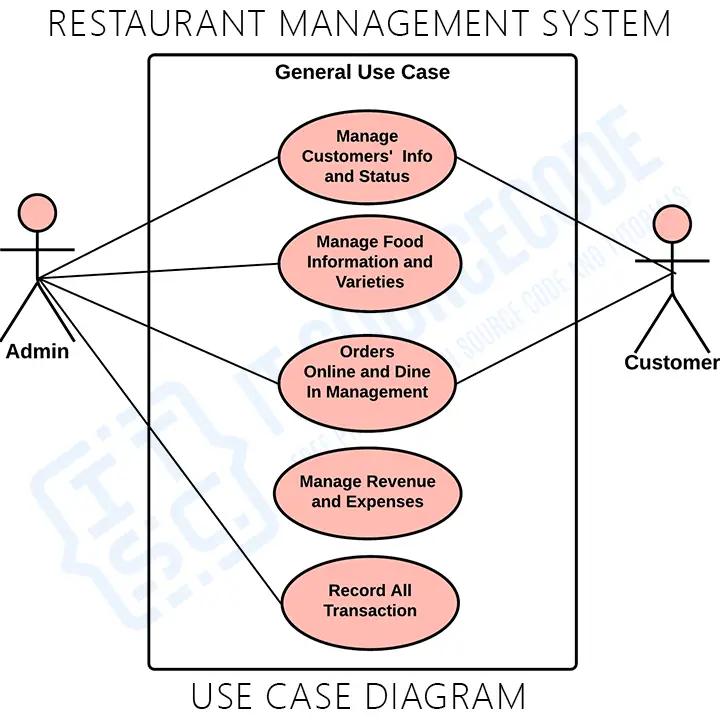
Use Case Diagram using Include and Extend
The use case diagram using include and extend is used to elaborate the proceeding diagrams. The terms include and extend in the use case diagram are known as indicators.
Manage Customers’ Information and Status
In this process, users were able to trace the orders and payments of their customers in every transaction. These were essential in doing their inventories and summation of their revenues.
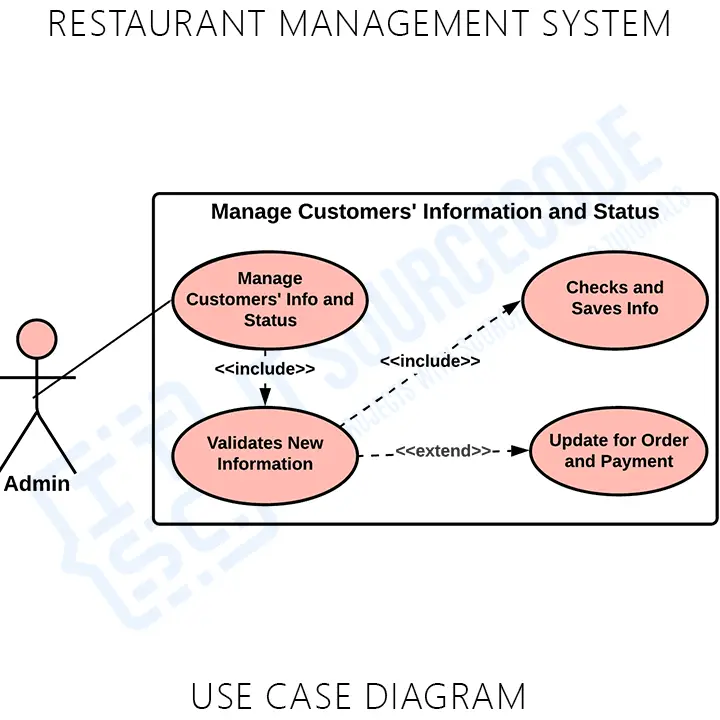
Manage Food Information and Varieties
Its process includes the recording of the food supplies and encoding of the food varieties that they offer to their customers. It emphasizes more on the system functions.
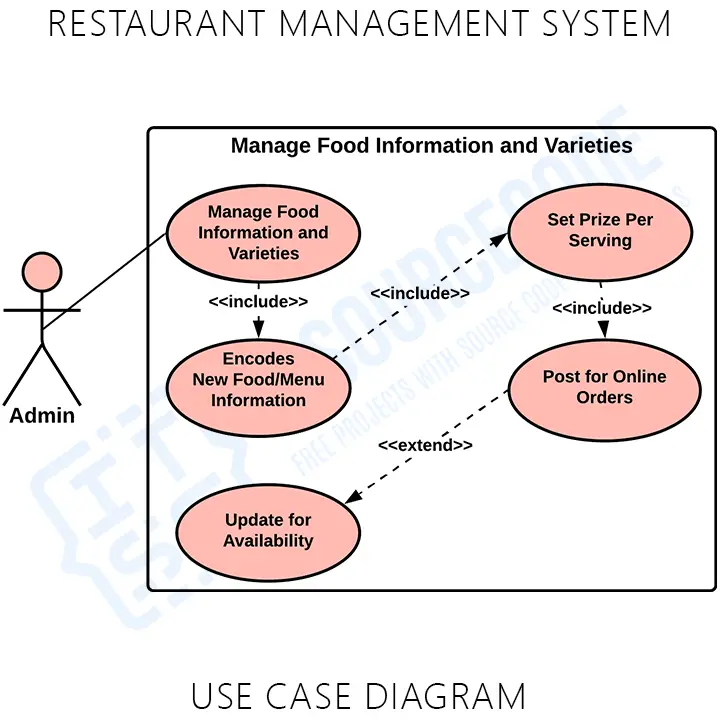
Manage Orders Online and Dine In
This process shows how the system admin handles the data given by their customers in terms of their orders. these orders were categorized whether it is dine-in or ordered online.
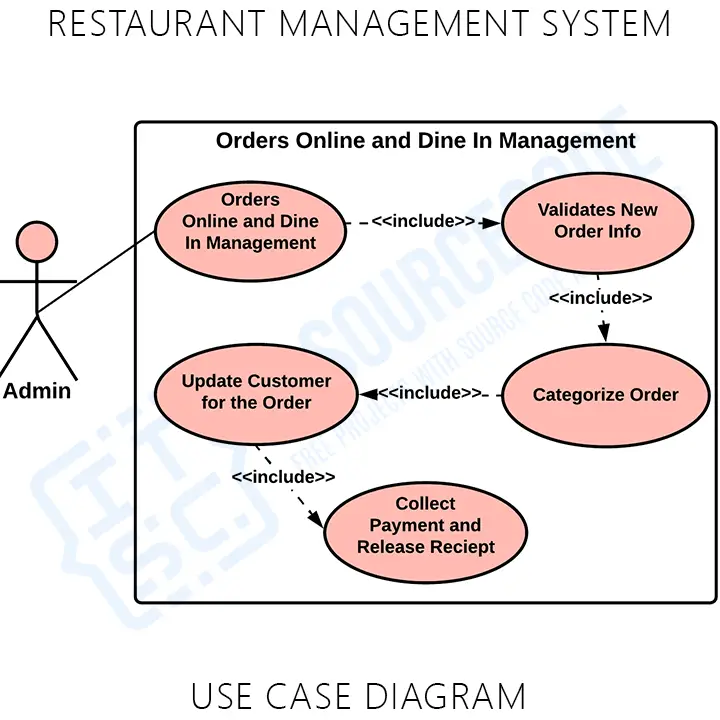
Manage Revenue and Expenses Use Case Diagram
This shows how the admin handles the income calculations and summation based on the data fed into the system. This is one of the important roles of the system which a programmer must put into priority.
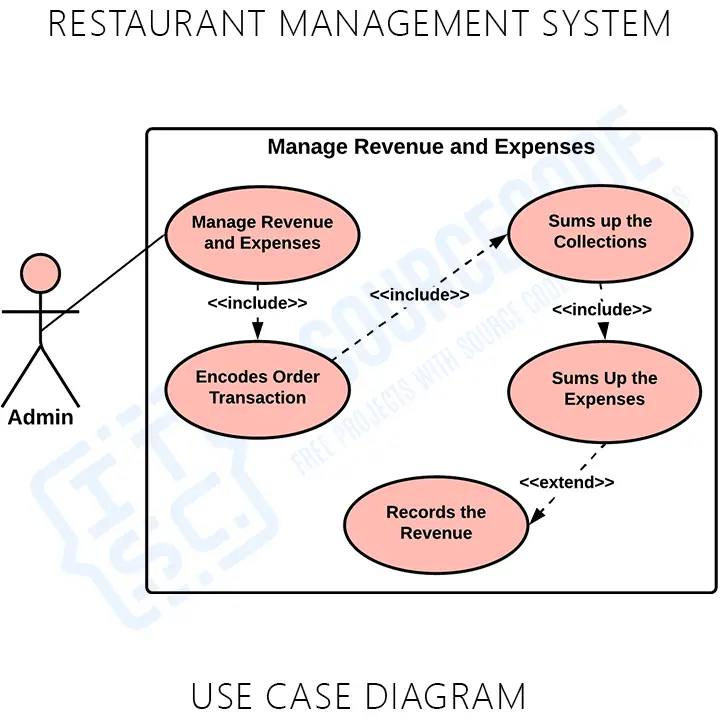
The “include” indication means that the following use case was compulsory to finish the task and the “extend” indication is otherwise.
You can add more to this illustration and it is up to you how will you create your diagram. But make sure to have precise information and consider the included use cases.
Downloadable Pdf File
How to draw a Use Case Diagram?
Time needed: 2 minutes
Here’s the complete guide on how to draw a use case diagram for restaurant management system.
- Step 1: Familiarize Use Case Diagram Symbols
For beginners in the field of designing the diagram, you need first to familiarize the symbols to be used.
- Step 2: Determine the targeted users
The next step is to determine your targeted users. They will be the ones to use your project.
You may ask the users about the typical activities done in restaurant management. - Step 3: Analyze the use cases included
The gathered information from the users needs to be evaluated to know the general use cases.
From the general use cases, you will see the sub-cases that are included. But, only the useful processes and circumstances related to the restaurant management system. - Step 4: Plot the Use Case Diagram
To plot the diagram you will need the users, use cases, container (scope), and their indicators (association). You will base the flow of use cases on the evaluated information from the users.
You need to place first the users involved. then the container (scope) of the project.
Then place the figured use cases included in doing the process.
After that, you will trace the association of the use cases. This will show the interactions between the user/s and the system.
Conclusion
One of the methods that contribute to the restaurant management system development is the UML use case diagram. It helps developers know the possible inputs that the project should process and perform.
Furthermore, you will find out the needed processes and connect them to the other UML Diagrams. The diagram is also applicable in modeling the software’s use cases (processes). It also captures the system’s flow from one process to the next.
Related Articles
- Restaurant Management Project Use Case Diagram
- Restaurant Management UML Diagrams
- ER Diagram for Restaurant Management System
- Chapter 3: Online Restaurant Management System project documentation
- Activity Diagram for Restaurant Management System
- Component Diagram for Restaurant Management System
- Restaurant Management Class Diagram
- Restaurant Management Sequence Diagram
Inquiries
If you have concerns about the Use Case Diagram for Restaurant Management System, just leave us your comments below.

